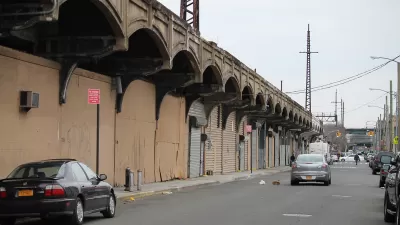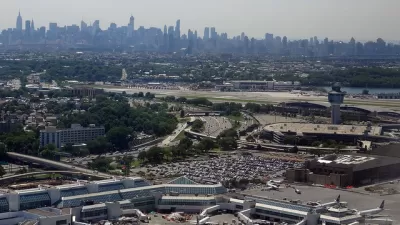Queen's version of Manhattan's High Line is known as the QueensWay, an abandoned LIRR branch that went from Rego Park to Rockaway. Two congressmen have now endorsed a plan to bring the train back - though planning for the new park has already begun.

It could be viewed as a case of "rails to trails", or rails to rails. It's also a competition between 'active transportation', i.e. walking and biking (and do note that the 'original' High Line prohibits biking) and commuter rail. Each side has their advocates.
With the support of two area congressmen, the rail advocates now have some political clout.
Domenick Rafter writes that "(a) source familiar with the plan to bring transit back to the line, which runs from Rego Park to the Rockaways and has been abandoned since 1962, said it will get the backing of the two Congressmen representing southern Queens."
The source says Reps. Hakeem Jeffries (D-Brooklyn) and Greg Meeks (D-Jamaica), whose districts meet at the Ozone Park section of the line, will endorse the proposal and push to allocate federal transportation subsidies to study a plan for bringing rail service back.
The rail idea has been championed by officials in the Rockaways, especially Assemblyman Phil Goldfeder (D-Rockaway Park). Supporters of reactivating the line, which connects to the Long Island Rail Road's (LIRR)) main route into Penn Station at Rego Park, say it would drastically cut commute times for Rockaway residents, which are among the highest in the city. When the LIRR went to Rockaway Park in the 1950s, it took only about 40 minutes to get from the peninsula to Penn Station. Today, a ride on the A train could take more than twice that.
In January, the Queensway plan was reported here, and is championed by the Friends of The QueensWay. (For images past and present, click on 'gallery').
The last train ran down the line in June 1962 and the route south of Rockaway Boulevard is now occupied by the A train.
The news (of the expected endorsement of the congressmen) comes after New York Times opinion writer Eleanor Randolph penned a column last weekend about the other proposed plan for the line — the Queensway.
Randolph wrote that the project was awarded a "$467,000 environmental protection grant through the state’s Office of Parks, Recreation and Historic Preservation. The grant will help pay for a community planning survey and a feasibility study..."
Both alternatives share at least one all too familiar aspect of much local planning - local opposition. Rafter writes of a new "movement, 'No Way Queensway,' aimed at killing both the rail and park plans."
Correspondent's note: Both congressmen endorsed the 'rails to rails' alternative plan. It will be referenced as a comment below after the article is published in the Queens Chronicle.
FULL STORY: Rockaway Beach rail plan to be backed by Reps. Jeffries, Meeks

Study: Maui’s Plan to Convert Vacation Rentals to Long-Term Housing Could Cause Nearly $1 Billion Economic Loss
The plan would reduce visitor accommodation by 25,% resulting in 1,900 jobs lost.

North Texas Transit Leaders Tout Benefits of TOD for Growing Region
At a summit focused on transit-oriented development, policymakers discussed how North Texas’ expanded light rail system can serve as a tool for economic growth.

Why Should We Subsidize Public Transportation?
Many public transit agencies face financial stress due to rising costs, declining fare revenue, and declining subsidies. Transit advocates must provide a strong business case for increasing public transit funding.

How to Make US Trains Faster
Changes to boarding platforms and a switch to electric trains could improve U.S. passenger rail service without the added cost of high-speed rail.

Columbia’s Revitalized ‘Loop’ Is a Hub for Local Entrepreneurs
A focus on small businesses is helping a commercial corridor in Columbia, Missouri thrive.

Invasive Insect Threatens Minnesota’s Ash Forests
The Emerald Ash Borer is a rapidly spreading invasive pest threatening Minnesota’s ash trees, and homeowners are encouraged to plant diverse replacement species, avoid moving ash firewood, and monitor for signs of infestation.
Urban Design for Planners 1: Software Tools
This six-course series explores essential urban design concepts using open source software and equips planners with the tools they need to participate fully in the urban design process.
Planning for Universal Design
Learn the tools for implementing Universal Design in planning regulations.
City of Santa Clarita
Ascent Environmental
Institute for Housing and Urban Development Studies (IHS)
City of Grandview
Harvard GSD Executive Education
Toledo-Lucas County Plan Commissions
Salt Lake City
NYU Wagner Graduate School of Public Service




























